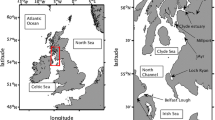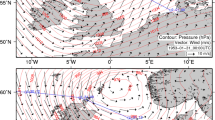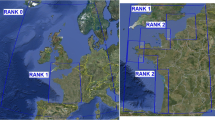Abstract
The Pertuis Charentais are shallow coastal embayments formed by the islands of Oleron and Re in the north-eastern Bay of Biscay. The low-lying coasts of the Pertuis Charentais are susceptible to extensive flooding caused by the storm surges generated in the North Atlantic. Numerical modelling of the 24 October 1999 surge event is performed in the present study in order to elucidate the impact of the wind-wave-tide-surge interactions on the surge propagation in the Pertuis Charentais. A 2D numerical model is constructed to simulate the wave and tide-surge propagation on a high-resolution finite-element grid by using the TELEMAC and TOMAWAC software. The effect of the wave-induced enhancement on the sea surface drag and on the bottom friction is evaluated by using the models of Janssen (1991) and Christoffersen and Jonsson (1985), respectively. The radiation stress is estimated by employing the approach of Longuet-Higgins and Stewart (1964). It is demonstrated that the peak surge in the night on 23–24 October has been amplified inside the Pertuis Charentais by about 20 cm due to the wind-wave interactions with the tide-surge currents. These interactions are strongest at the entrance to the Pertuis Charentais where the sea surface drag coefficient is significantly increased by the wind-wave coupling. The effect of the wave-tide-surge interactions is large enough to be included in the flood forecasting systems of this region.













Similar content being viewed by others
References
Benoit M (2003) Logiciel TOMAWAC de modélisation des états de mer en éléments finis. Notice théorique de la version 5.2. Note technique EDF R&D LNH HP-72/02/065/A
Benoit M, Marcos F, Becq F (1996) Development of a third generation shallow water wave model with unstructured spatial meshing. In: Proc. 25th Int. Conf. on Coastal Eng. (ICCE'1996), 2–6 Septembre 1996, Orlando (Florida, USA), pp 465–478
Benoit M, Marcos F, Janin JM (1997) Interactions atmosphère/houle/marée/surcotes appliquées à la simulation des tempêtes en mer. In: Proc. Symp. Saint-Venant “Analyse Multiéchelle et systèmes physiques couplés”, 28–29 August 1997, Paris (France), pp 211–218 (in French)
Bernier NB, Thompson KR (2007) Tide-surge interaction off the east coast of Canda and northeastern United States. J Geophys Res v112, C06008. doi:10.1029/2006JC003793
Bowden KF, Krauel DP, Lewis RE (1974) Some features of turbulent diffusion from a continuous source at sea. Adv Geophys 18A:315–329
Brown J, Wolf J (2009) Coupled wave and surge modeling for the eastern Irish Sea and implications for model wind-stress. Cont Shelf Res 29:1329–1342
Carretero Albiach JC, Álvarez Fanjul E, Gómez Lahoz M, Pérez Gómez B, Rodríguez Sánchez-Arevalo I (2000) Ocean forecasting in narrow shelf seas: application to the Spanish coasts. Coastal Eng 41:269–293
Christoffersen JB, Jonsson IG (1985) Bed friction and dissipation in a combined current and wave motion. Ocean Eng 12(5):387–423
Davies AM, Lawrence J (1995) Modelling the effect of wave–current interaction on the three-dimensional wind-driven circulation of the Eastern Irish Sea. J Phys Oceanogr 25:29–45
Ezer T, Mellor GL (2000) Sensitivity studies with the North Atlantic sigma coordinate Princeton Ocean Model. Dyn Atmos Ocean 32(3/4):185–208
Flather RA (2000) Existing operational oceanography. Coastal Eng 41:13–40
Friedrichs CT, Madsen OS (1992) Nonlinear diffusion of the tidal signal in frictionally dominated embayments. J Geophys Res 97(C4):5637–5650
Heaps NS (1965) Storm surges on a continental shelf. Philos Trans R Soc London Ser A 257:351–383
Hervouet J-M (2007) Hydrodynamics of free surface flows, modelling with the finite element method. Wiley, Hoboken. ISBN 978-0-470-03558
Hervouet JM, Van Haren L (1994) Système de modélisation TELEMAC: TELEMAC-2D note de principe. LNHE de l’EDF (in French)
Idier D, Pedreros R, Oliveros C, Sottolichio A, Choppin L, Bertin X (2006) Contributions respectives des courants et de la houle dans la mobilite sedimantaire d'une plate-forme interne estuarienne. Exemple: le seuil interinsulaire, au large du Pertuis d'Antioche, France, Comptes Rendus. Geoscience 338:718–726
Janssen PAEM (1991) Quasi-linear theory of wind–wave generation applied to wave forecasting. J Phys Oceanogr 19:745–754
Jones JE, Davies AM (1998) Storm surge computations for the Irish Sea using a three-dimensional numerical model including wave–current interaction. Cont Shelf Res 18:201–251
JONSWAP Group (1973) Measurements of wind-wave growth and swell decay during the Joint North Sea Wave Project. Dtsch Hydrogr Z A8:95
Le Blond PH (1978) On tidal propagation in shallow rivers. J Geophys Res 83:4717–4721
Le Roy R, Simon B (2003) Réalisation et validation d’un modèle de marée en Manche et dans le Golfe de Gascogne. SHOM Rapport d’étude no. 002/03
Longuet-Higgins MS, Stewart RW (1964) Radiation stresses in water waves; a physical discussion, with application. Deep-Sea Res 11:526–562
Luettich RA Jr., Westerink JJ, Scheffner NW (1992) ADCIRC: an advanced three-dimensional circulation model for shelves, coasts, and estuaries. Technical Report DRP-92-6, US Army Engineer Waterways Experiment Station, Vicksburg
Mastenbroek C, Burgers G, Janssen PAEM (1993) The dynamical coupling of a wave model and a storm surge model through the atmospheric boundary layer. J Phys Oceanogr 23:1856–1866
Nicolle A (2006) Modélisation des marées et des surcotes dans les Pertuis Charentais (Golfe de Gascogne), Ph.D. thesis, Université de La Rochelle, 307 pp
Nicolle A, Karpytchev M (2007) Evidence for spatially variable friction from tidal amplification and asymmetry in the Pertuis Breton (France). Cont Shelf Res 27:2346–2356
Parker B (1984) Frictional effects on the tidal dynamics of a shallow estuary. Ph.D. Thesis, John Opkins University, Baltimore, 292 pp
Proudman J (1953) Dynamical oceanography. Methuen, London 409 pp
Smith SD, Banke EG (1975) Variation of the sea surface drag coefficient with wind speed. Q J R Meteor Soc 101:665–673
Williams JA, Flather RA (2000) Interfacing the operational storm surge model to a new mesoscale atmospheric model. POL Internal Document, No. 127, Proudman OceanographicLab., Liverpool, 18 pp
Wolf J, Hubbert KP, Flather RA (1988) A feasible study for the development of a joint surge and wave model. Proudman Oceanographic Laboratory, Rep. N1
Wolf J (2009) Coastal flooding—impacts of coupled wave–surge–tide models. Natural Hazards v.9:241–260
**e L, Pietrafesa LJ, Wu K (2003) A numerical study of wave–current interaction through surface and bottom stresses: coastal ocean response to Hurricane Fran of 1996. J Geophys Res 108(2):3049
Acknowledgements
The authors acknowledge the anonymous reviewers for the helpful and constructive comments. M.K. thanks J. Wolf for insightful comments regarding results of this study. The authors thank L. Pineau-Guillou for supplying the observations at Chapus. This work was partially supported by Conseil General de Charente-Maritime (Ph.D. Fellowship to A.N.) and by the National Research Agency project ANR VASIREMI.
Author information
Authors and Affiliations
Corresponding author
Additional information
Responsible Editor: Phil Dyke
Rights and permissions
About this article
Cite this article
Nicolle, A., Karpytchev, M. & Benoit, M. Amplification of the storm surges in shallow waters of the Pertuis Charentais (Bay of Biscay, France). Ocean Dynamics 59, 921–935 (2009). https://doi.org/10.1007/s10236-009-0219-0
Received:
Accepted:
Published:
Issue Date:
DOI: https://doi.org/10.1007/s10236-009-0219-0




